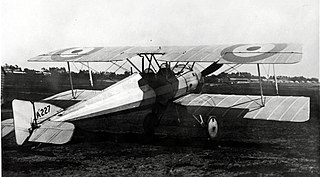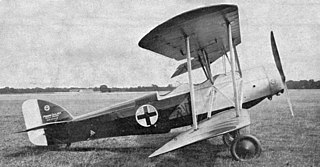
The Nieuport 17 C.1 is a French sesquiplane fighter designed and manufactured by the Nieuport company during World War I. An improvement over the Nieuport 11, it was a little larger than earlier Nieuports and better adapted to the more powerful engine than the interim Nieuport 16. Aside from early examples, it had the new Alkan-Hamy synchronization gear, permitting the use of a fuselage-mounted synchronised Vickers gun firing through the propeller disc.

The Morane-Saulnier N, also known as the Morane-Saulnier Type N, was a French monoplane fighter aircraft of the First World War. Designed and manufactured by Morane-Saulnier, the Type N entered service in April 1915 with the Aéronautique Militaire designated as the MoS-5 C1. It also equipped four squadrons of the Royal Flying Corps, in which it was nicknamed the Bullet, and was operated in limited numbers by the 19th Squadron of the Imperial Russian Air Force.

The Morane-Saulnier L, or Morane-Saulnier Type L, or officially MoS-3, was a French parasol wing one or two-seat scout aeroplane of the First World War. The Type L became one of the first successful fighter aircraft when it was fitted with a single machine gun that fired through the arc of the propeller, which was protected by armoured deflector wedges. Its immediate effectiveness in this role launched an arms race in fighter development, and the Type L was swiftly rendered obsolete. The original Type L used wing warping for lateral control, but a later version designated Type LA was fitted with ailerons.

The Morane-Saulnier Type P was a French parasol wing two-seat reconnaissance aeroplane of the First World War. Morane-Saulnier built 595 for the French air force, and it was also used by the British until 1916-17.

The Nieuport 11, nicknamed the Bébé, is a French World War I single seat sesquiplane fighter aircraft, designed by Gustave Delage. It was the primary aircraft that ended the Fokker Scourge in 1916. The type saw service with several of France's allies, and gave rise to the series of "vee-strut" Nieuport fighters that remained in service into the 1920s.

The Nieuport 27 was a World War I French sesquiplane fighter aircraft designed by Gustave Delage. The 27 was the last of the line of Nieuport "V-strut" single seat fighters that began with the Nieuport 10 of 1914. Operational examples supplemented the very similar Nieuport 24 and 24bis in operational squadrons in late 1917 and many would also be used as advanced trainers.

The Nieuport 12 was a French sesquiplane reconnaissance, fighter aircraft and trainer used by France, Russia, Great Britain and the United States during World War I. Later production examples were built as trainers and served widely until the late 1920s.

The Caudron R.4 was a French World War I twin-engine biplane reconnaissance/artillery cooperation aircraft and the progenitor of a series of successful aircraft that filled a variety of roles with the French Aéronautique Militaire.

The Morane-Saulnier M.S.225 was a French fighter aircraft of the 1930s. It was produced in limited quantities to be used as a transitional aircraft between the last of the biplanes and the first monoplane fighters.

The Morane-Saulnier AI was a French parasol-wing fighter aircraft produced by Morane-Saulnier during World War I.
The Morane-Saulnier V, also known as the Morane-Saulnier Type V was a French fighter of the 1910s.
The Morane-Saulnier AF, also known as the Morane-Saulnier Type AF and the MoS 28 was a French First World War single-seat biplane fighter prototype from 1917.
The Morane-Saulnier MS.43 was a French two-seat training biplane designed and built by Morane-Saulnier for a 1924 French War Ministry requirement for an intermediate training biplane.

The Morane-Saulnier AR was a trainer aircraft produced in France during and after the First World War.

The Morane-Saulnier BB was a military observation aircraft produced in France during World War I for use by Britain's Royal Flying Corps. It was a conventional single-bay biplane design with seating for the pilot and observer in tandem, open cockpits. The original order called for 150 aircraft powered by 110-hp Le Rhône 9J rotary engines, but shortages meant that most of the 94 aircraft eventually built were delivered with 80 hp Le Rhône 9C rotaries instead. A water-cooled Hispano-Suiza 8A engine was trialled as an alternative in the Type BH, but this remained experimental only. A production licence was sold to the Spanish company Compañía Española de Construcciones Aeronáuticas (CECA), which built twelve fitted with Hispano-Suiza engines in 1916.

The Morane-Saulnier MS.138 was a military trainer aircraft produced in France in the late 1920s,

The Morane-Saulnier MS.140 was designed in France as an ambulance aircraft with the ability to operate from small fields and which could double as a trainer. Only one of these single engine, wooden biplanes was built, first flying about 1927.
The Morane-Saulnier S,also known as MoS-10, was a large twin-engined biplane bomber designed and built in France around 1916. Powered by two 250 hp (190 kW) Renault 12E V-12 water-cooled piston engines, with Hazet type side radiators, the 'S' was given the STAé designation MoS-10 and serial MS-625.
The SPAD S.XV was a single-seat fighter designed and built in France and offered to fulfil a 1918 C1 specification.
The Morane-Saulnier TRK was a prototype French bomber built during World War I.















